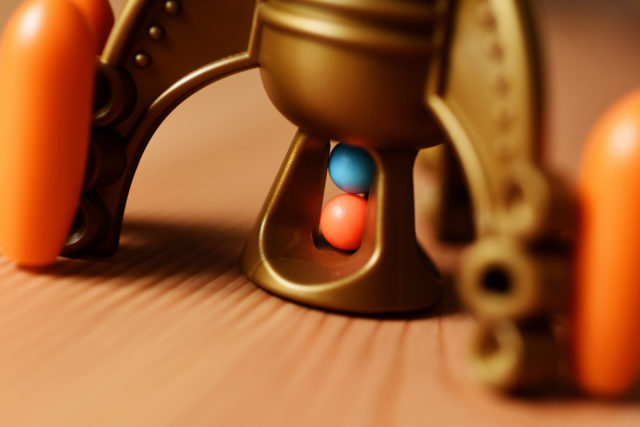By the time I first tried Settlers of Catan (now just Catan), Starfarers of Catan was already out of print and a “grail game” for many folks. In fact, I didn’t even hear about it until I was far enough into the hobby to really know what a grail game is! (An out-of-print, highly sought-after game). It’s not something I ever got to try out, even knowing people who owned the game — the glut of new releases and various formats of Catan digitally meant I never really felt the need. Catan Studios have decided to bring the beast from space back to shelves with a refreshed and restored Catan: Starfarers (in line with their modern branding). I won’t be giving you a comparison to the original game, but I absolutely will give you the rundown and my thoughts on this galaxy traveller.

If you’re like me, you may be expecting “Catan, but literally just in space instead” out of Starfarers. While the basics of Catan are the framework to the game, there’s some fun new parts of gameplay and strategy that give this enough distance from the franchise to be a solid choice to try. The closest comparison I can think of is Catan: Seafarers – there’s some transporting around the board, discovering resource tiles when you approach them, and (at a stretch) pirates. All of these things have been tailored to suit the setting of space very particularly in Starfarers and it’s impressive how well it all comes together. When you dive in for the first time, you’re going to want to use the suggested set up that comes in the rule book – a helpful guide for those just familiarizing themselves with the game. There are options for variable set-ups for folks who play enough to need a fresher approach and want to change things up for a challenge.
Players start the game with a number of colonies (akin to settlements), a spaceport (allowing the launch of ships) and one colony ship (a colony piece transported by a rocket). You’ll expand out into the system by moving with ships — so rather than building roads, you’ll spend movement points each turn to head out along the expansive board to reveal new production values on planet tiles. If you’re hauling a colony ship, you can establish that somewhere out there in order to up your chances of getting a handful of good resources most turns. Resources are not just used to establish colonies, trade outposts and spaceports — you’ll also be turning them into boosters, cannons and freight pods, upgrades that will respectively boost your speed, strength and ability to establish trade or liberate an ice planet. (Freeing it up to become another spot that produces resources for colonies built adjacently.)

You also have the option of taking a trade ship out, in order to establish an outpost at one of the four alien bases, which establishes friendship for you and that particular group. If you are the first, or have the majority of cards from that group you’ll take the standee that represents them, and is also worth two points! Each of the cards will offer a benefit of some kind, which offsets not getting points for establishing your outpost. This might be something that increases your production of a particular resource, boosts your ship’s upgrades, or even offers you better trading ratios. Depending on the board’s setup, you may find these easy to get to, or a little too far away to get to easily in the early-mid game. But they’re a really interesting piece of the game – if you work to harmonize your resource production with the benefits of say, trading and extra production, things will really pay off. Take a good look through these stacks of cards before playing, so you can have them in mind when heading out for trading.
Moving out into space is handled by using the incredibly overproduced rocket you have, with a number of coloured balls inside that you’ll shake up. Whatever shows in the hopper after this will indicate your base speed. If you’ve got any boosters on your ship that increase speed, add that on and then move any/all of your various ships out there into the big bad black. At times, you may end up with a black ball that comes up in your shaker results – this means a slightly lower base speed, and having to resolve an encounter before you take the rest of your turn. There’s quite a large stack of these encounter cards, and they range from basic encounters with stranded ships, space pirates, merchants and the like. The player to the left will read the card out and the player will choose from a yes/no option or something like offering up between 0 and 2 cards. I’ve seen a few of the same thing – say, space pirates – that don’t follow the exact forums as each of the other same type of card, which I was pleasantly surprised at. There’s no guessing to get you out of these things!

Now, this ship. It’s not… subtle, shall we say. I mean, the 4 of them take up about half of the box space! However, once I got to see how it worked to determine speed, strenghth and tracking, it made sense to have it be as visible as it is (which is quite). You could have dice for the speed and strength checks and a tracking board for your upgrades – but it’s far easier to have this ship clear and plain for everyone to see, and see how many upgrades you’re amassing. And, let’s face it, shaking these rockets is a fun way of a skill check in a game. Time to move! shake shake shake Ooh, gonna fight this space pirate! shake shake shake. It’s a part of your turn that everyone at the table stops to watch – and cheer on, if you succeed with an encounter! It’s a really stand-out unique part of this game that sets it apart from vanilla Catan to me.
The other big stand-out to me is the idea of transporting your colonies and trade outposts. You don’t have to spend time and resources building up a road or transport network — once you’ve pooled the resources for the particular ship, you’re off and racing. Even though the board takes up some big real estate on the table, I felt like I was getting around it pretty well given the base speed and the upgrades that you can load onto the ship. Or, if you’re lucky, an encounter might lead you to a bonus space jump to anywhere on the board! The encounters feel just random enough, but you can still have some agency based on your decisions or the maintenance of upgrades on your ship in preparation for various skill checks. As mentioned previously, not all of the encounters offer the same decision tree – for instance, merchant cards will sometimes have a scathing reply to offering up zero resources, or perhaps you’ll end up pitied! I don’t feel like it detracted from the enjoyment of the game, even if there can occasionally be setbacks like losing upgrades or resources. Enough for a bit of spice, without being game-breaking.

I’ve given a fairly high-level discussion of the game here – there’s lot of nitty gritty that matters when you’re sitting at the table, but I can safely skip that here and still feel like I’ve given you a decent grasp of the experience. If you’re familiar with Catan, then Starfarers won’t take too much familiarization, but at the same time don’t assume you’re going to know the ins and outs! I do feel like this is going to be worth giving a whirl even if you’ve moved on from Catan — or even if you’ve never played it! Even the play time is not too wildly different, which might be a concern of many who’d be interested. But don’t take my word for it — unless you’ve maybe got an ore and a fuel in return?
—
Catan: Starfarers is an exploration and trading game for 3 – 4 players, taking approximately 90 – 120 minutes. Designed by Klaus Teuber, with art by Michaela Kienle & Franz Vohwinkel, it is published by Catan Studios. Thank you to Asmodee North America and Catan Studios for sending us this
Comments
No comments yet! Be the first!